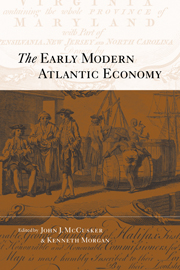Book contents
- Frontmatter
- Contents
- List of figures
- List of tables
- List of abbreviations
- List of contributors
- Dedication
- Introduction
- Part I The role of merchants and their connections
- Part II The development of trades
- 3 Property versus commerce in the mid-eighteenth-century port of London
- 4 Irish businessman and French courtier: the career of Thomas sutton, comte de Clonard, c. 1722–1782
- 5 ‘A revolution in the trade’: wine distribution and the development of the infrastructure of the Atlantic market economy, 1703–1807
- 6 Law, credit, the supply of labour, and the organization of sugar production in the colonial Greater Caribbean: a comparison of Brazil and Barbados in the seventeenth century
- 7 The revolutionary impact of European demand for tropical goods
- 8 The business of distilling in the Old World and the New World during the seventeenth and eighteenth centuries: the rise of a new enterprise and its connection with colonial America
- Part III Imperial economies
- Part IV Colonial working societies
- Index
8 - The business of distilling in the Old World and the New World during the seventeenth and eighteenth centuries: the rise of a new enterprise and its connection with colonial America
from Part II - The development of trades
Published online by Cambridge University Press: 16 October 2009
- Frontmatter
- Contents
- List of figures
- List of tables
- List of abbreviations
- List of contributors
- Dedication
- Introduction
- Part I The role of merchants and their connections
- Part II The development of trades
- 3 Property versus commerce in the mid-eighteenth-century port of London
- 4 Irish businessman and French courtier: the career of Thomas sutton, comte de Clonard, c. 1722–1782
- 5 ‘A revolution in the trade’: wine distribution and the development of the infrastructure of the Atlantic market economy, 1703–1807
- 6 Law, credit, the supply of labour, and the organization of sugar production in the colonial Greater Caribbean: a comparison of Brazil and Barbados in the seventeenth century
- 7 The revolutionary impact of European demand for tropical goods
- 8 The business of distilling in the Old World and the New World during the seventeenth and eighteenth centuries: the rise of a new enterprise and its connection with colonial America
- Part III Imperial economies
- Part IV Colonial working societies
- Index
Summary
Five hundred years intervened between the introduction of the process of alcoholic distillation into Europe and the development of the alcoholic beverage distilling industry there. The distilling of spirits in the West dates from roughly 1150. Even though beer and wine had been known and drunk widely for several millennia before the first European tasted distilled spirits, a clear preference for distilled spirits emerged rapidly, no doubt because of their greater potency. Yet the widespread realization of that preference and the establishment of an industry to serve it were initially thwarted by the considerably higher price for spirits than for beer and wine. Distilled alcoholic beverages became products of mass consumption only after 1650.
Two developments in the middle years of the seventeenth century combined to lower the cost of spirits sufficiently for people to afford to substitute them for wine and beer. First, improvements in the distilling apparatus were implemented that greatly increased the scale on which distilling could be conducted. Second, sugar and sugar byproducts emerged as new, cheap base materials to be distilled in the larger, more efficient apparatus. Much of this change had its roots in the New World where sugar planters had learned by the late sixteenth century to distil rum from sugar-cane juice and sugar-cane molasses.
Five hundred years intervened between the introduction of the process of alcoholic distillation into Europe and the development of the alcoholic beverage distilling industry there.
- Type
- Chapter
- Information
- The Early Modern Atlantic Economy , pp. 186 - 224Publisher: Cambridge University PressPrint publication year: 2001



